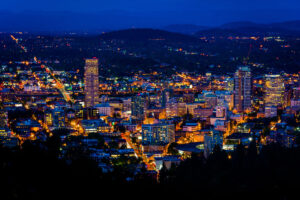Glassy Mornings And Golden Shores – Why Fall Is For Paddlers
Autumn in Oregon is a season of pause and poetry. As the crowds thin along the lakeshore and the wind carries the scent of cedar and wet leaves, the water begins to reflect more than just trees. It reflects the quiet turning of the year. For paddlers, this is the secret season, featuring glassy mornings, crisp air, and the soft, rhythmic dip of a paddle that feels almost like meditation.
The repose of fall brings a different kind of beauty to the water, one that asks for patience, presence, and a willingness to move slowly. Each stroke feels deliberate, almost sacred. The water doesn’t rush but listens. Here’s why this brief window belongs to paddlers, and how to make the most of it.
Fall is Made For Paddlers
The beauty of paddling in autumn isn’t only in what you see, it’s in what you don’t. The bugs are gone. The boat ramps are mostly empty. The heat has dissipated into a pleasant coolness. With fewer people and less noise, every paddle stroke seems to matter more.
For solitude seekers, fall is abundant. Lakes like Waldo and Timothy clear out completely, leaving the kind of silence that amplifies every bird call and ripple. Even Oregon’s popular routes from the Deschutes to the Upper Klamath offer stretches where you can drift for miles without seeing another soul.
There’s a rhythm to this season, a steady inhale and exhale between storm fronts. Paddling becomes less about adventure and more about belonging to the water, to the air, and to the brief moment before the rains return. It’s the kind of stillness that only fall seems to offer, and it’s fleeting enough to feel like a secret.
The Stillness That Moves You
When the summer frenzy fades, Oregon’s waterways transform. Sparks Lake near Bend, once alive with paddleboarders and picnickers, becomes a tranquil alpine mirror where the Three Sisters seem close enough to touch. Early risers at Trillium Lake can watch Mount Hood awaken in perfect reflection while mist curls across the surface like breath.
In the Willamette Valley, rivers slow and deepen in color. A kayak trip along the Santiam or North Fork offers amber light filtering through bigleaf maples, while the sound of water against the hull feels like a steady heartbeat. On the coast, tucked behind dunes at Nehalem Bay or Siltcoos Lake, you can still sense the ocean’s distant pulse that serves as a reminder that all Oregon waters eventually find their way to the sea.
And for those who venture out early enough, there’s the moment when fog lifts and reveals a world remade into mirrored skies, rippling gold, and a silence so complete it feels alive.
Autumn Paddle Safety and Gear Checklist
Autumn paddling rewards the prepared. The air may feel mild, but the water is cold enough to command respect. This time of year, the water cools quickly, even on sunny days.
- Dress for immersion, not air temperature: A wetsuit, drysuit, or neoprene layers prevent hypothermia in case of capsizing.
- Layer wisely: Fleece or wool under a waterproof shell keeps you warm without trapping in moisture.
- Pack essentials: Bring a dry bag with extra layers, gloves, snacks, a headlamp, and a thermos of something hot.
- Plan ahead: Check wind advisories, daylight hours, and river levels as all shift rapidly this time of year.
- Stay visible: Reflective tape on your paddle and PFD helps in the dimming light.
- Photography tip: Reflections are sharpest in early light, so shoot low to the waterline in the morning.
- Respect the season: Leave no trace, paddle quietly, and give wildlife space to move through their migration routes.
If you’re new to paddling, autumn can be surprisingly kind. The waters are calm, the winds are softer, and outfitters from Bend to the Coast, like Alder Creek Kayak & Canoe, Tumalo Creek Kayak & Canoe, and South Coast Tours, often offer off-season rentals and guided trips designed for beginners.
Where to Launch In The Fall
- Waldo Lake (Cascade Lakes Highway): Oregon’s clearest water, often glassy by morning and perfect for reflection photography.
- Nehalem River Estuary (North Coast): Tidal paddling among elk, egrets, and salt marshes burning gold.
- Silver Lake (Southern Oregon): High desert stillness and migrating waterfowl overhead.
- Detroit Lake (Willamette National Forest): A place of renewal with young firs reclaiming the slopes and mirrored in calm water.
- Columbia Slough (Portland): Urban paddling with surprising serenity, with the city reflected in amber light.
- Siltcoos River Trail (Oregon Dunes): A winding route where freshwater meets sand and the Pacific Ocean.
The best window for glassy conditions in these waterways is from dawn to ~2 hours after sunrise, and again in the last 90 minutes before sunset. Aim for winds < 8–10 mph.
Reflections Beyond the Surface
There’s something about autumn water that mirrors more than scenery. Maybe it’s the season itself being introspective, fleeting, and balanced between abundance and decline. Each ripple becomes a small act of presence and serves as a reminder to move slowly and notice the details like the slow drift of a leaf settling on the water’s surface, the sound of wings as geese take to the sky, and the low sun gilding the shore.
To paddle in the fall is to practice attention. It’s the quiet acknowledgment that movement doesn’t have to mean rushing, that sometimes the best journeys are the ones that loop back to stillness.
So this fall, find your waterway and bring your paddle. Oregon’s quiet waters are waiting as mirrors to both the world and yourself.
Share this content:














Post Comment